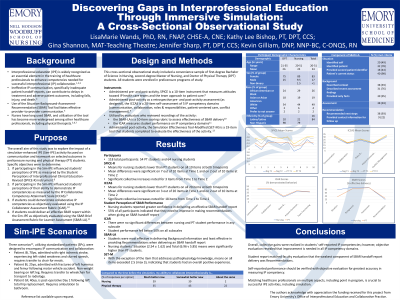Education
(44) Discovering Gaps in Interprofessional Education Through Immersive Simulation: A Cross-Sectional Observational Study
Thursday, June 19, 2025
5:00 PM - 6:30 PM MST
Location: Exhibit Hall

.jpg)
LisaMarie Wands, PhD, RN, FNAP, CHSE-A, CNE (she/her/hers)
Associate Clinical Professor
Emory University, Nell Hodgson Woodruff School of Nursing
Atlanta, GA, United States
Lead Author(s)
Abstract: An interprofessional (IP) simulation was implemented with nursing and physical therapy students with the intention to (1) increase self-perceived IP competencies; (2) to gauge students' ability to deliver an effective Situation-Background-Assessment-Recommendation (SBAR) handoff report; and (3) compare faculty evaluation of competencies and SBAR reports with students' self-reported capabilities. Sixty-four pre-licensure nursing and 57 doctor of physical therapy (DPT) students completed the simulation and pre- and post-tests, which included the Student Perceptions of Interprofessional Clinical Education-Revised (SPICE-R) and Interprofessional Collaborative Competency Attainment Scale (ICCAS). Students worked in dyads to care for a standardized patient. Simulations were recorded, and faculty reviewed recordings to evaluate students' performance of SBAR report using the SBAR-Learner Assessment rubric and the Interprofessional Collaborate Assessment Rubric (ICAR). Students' responses collectively indicated positive change from Time 1 to Time 2 on IP competencies. First-degree nursing students' responses were lowest at Time 1 and demonstrated greatest increases in positive perceptions of IP education than second-degree nursing or DPT students. Objective evaluation of student IP collaboration is lower than students' self-perception. Some data was lost to technical issues with audio recordings. Interrater reliability was conducted on use of the ICAR to evaluate students' recorded performance. Identifying the prime point in different professional degree programs is vital for learning.
Please include a short summary of your presentation that highlights why an attendee would want to view your poster.: Interprofessional simulation education supports students' perceived ability to collaborate, but objective evaluation of performance indicates further educations is needed.
Please include a short summary of your presentation that highlights why an attendee would want to view your poster.: Interprofessional simulation education supports students' perceived ability to collaborate, but objective evaluation of performance indicates further educations is needed.
Learning Objectives:
- After engaging with the poster, participants will consider how to implement an interprofessional simulation activity in their own institutions.
- After engaging with the poster, participants will understand how to use the instruments utilized in the study (e.g., Interprofessional Collaborative Competency Attainment Scale; Interprofessional Collaborator Assessment Rubric; SBAR-Learner Assessment).
- After engaging with the poster, participants will analyze the difference between students' self-perception of and objective evaluation of their performance of Interprofessional competencies.
